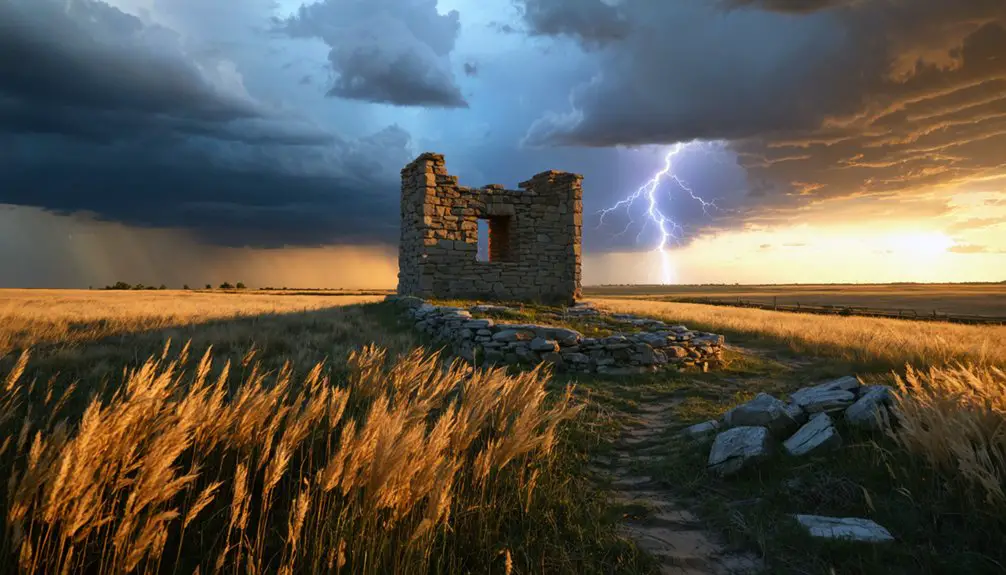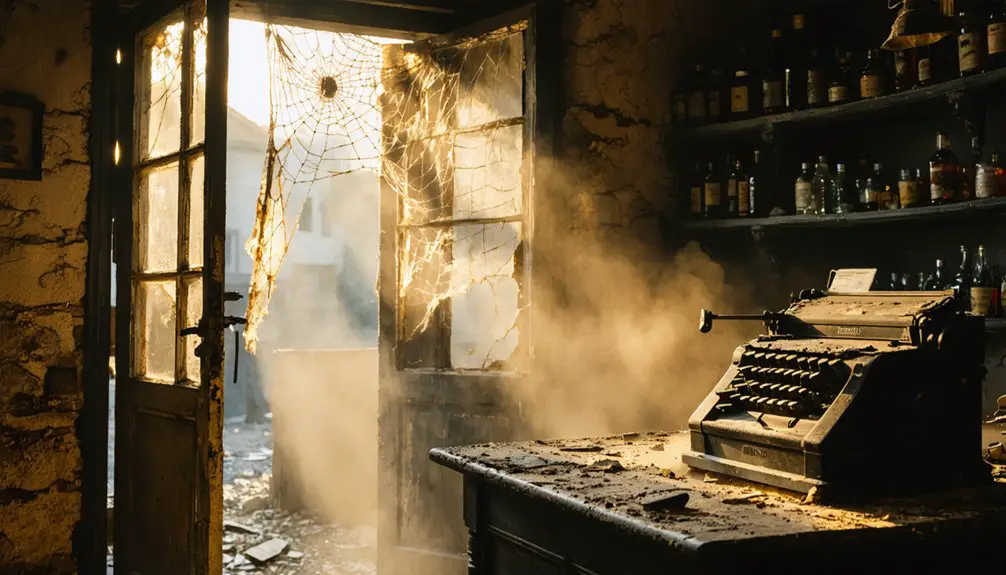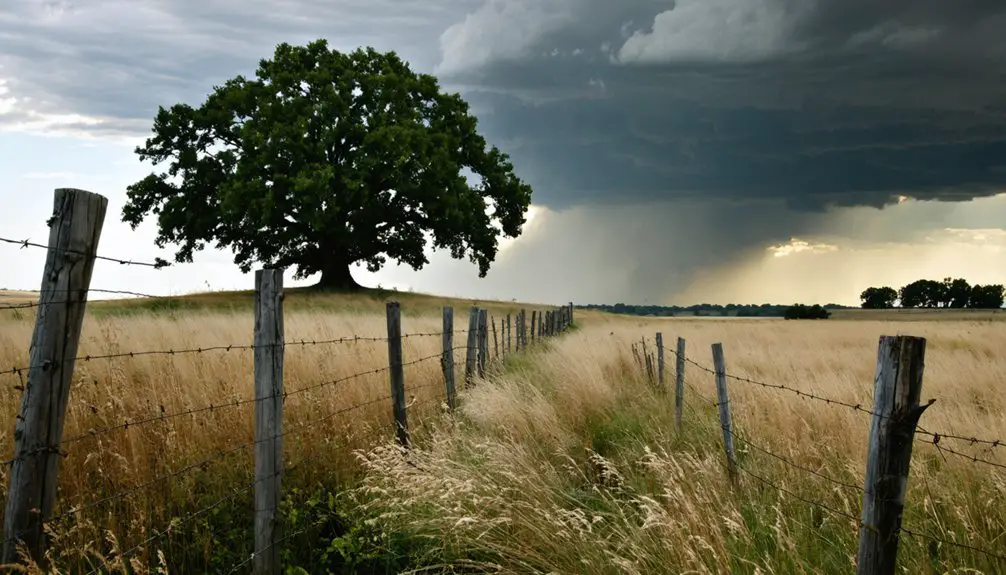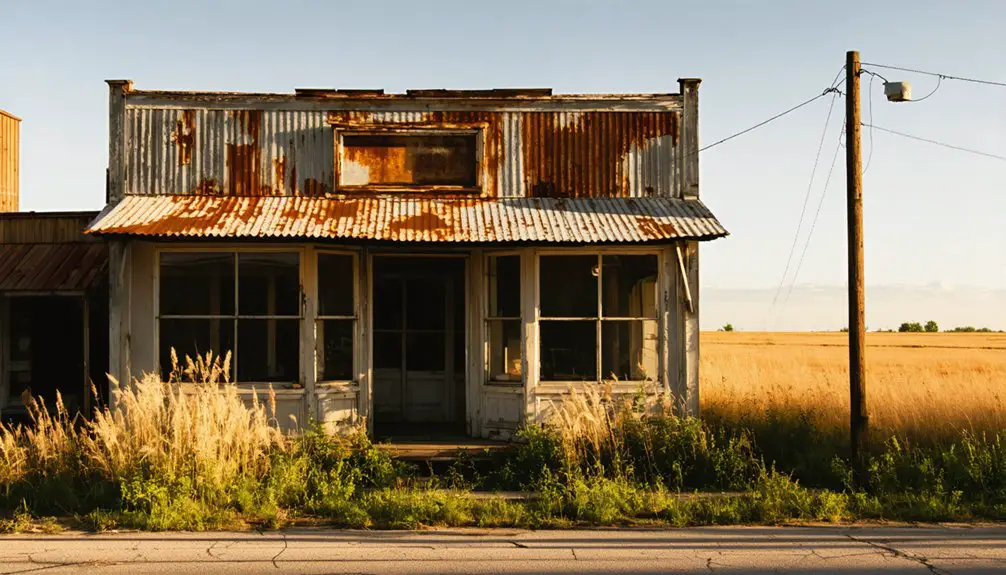You’ll find Black Jack’s remains along the historic Santa Fe Trail in Kansas, where it flourished as an essential trading post in 1855. The town gained national attention during the Kansas-Missouri Border War when John Brown’s forces defeated pro-slavery militia in the Battle of Black Jack. Though the settlement declined after the railroad’s arrival, you can still explore the battlefield site, now a National Historic Landmark where deeper layers of frontier history await.
Key Takeaways
- Black Jack, Kansas, established in 1855 along the Santa Fe Trail, is now a ghost town with few remaining original structures.
- The site gained historical significance as the location of the 1856 Battle of Black Jack between John Brown and pro-slavery forces.
- The town’s decline began after the Kansas-Missouri Border War and the railroad’s arrival redirected trade routes away from Black Jack.
- Located in high rolling prairie land with wooded ravines, the area preserves the natural landscape that influenced the historic battle.
- The battle site is designated as a National Historic Landmark, attracting Civil War historians despite the town’s abandoned status.
The Birth of a Frontier Settlement
When settlers established Black Jack, Kansas, in 1855 along the Santa Fe Trail, they couldn’t have predicted its pivotal role in the territory’s explosive political climate.
You’ll find the frontier challenges faced by early pioneers like William Riley and David Fearer were intensified by the settlement’s strategic location as a supply point for traders. The town’s first post office opened in 1858, with S.A. Stonebraker serving as postmaster.
Named after Black Jack Creek by Mexican travelers, the town emerged during a critical period when the Kansas-Nebraska Act sparked fierce settlement dynamics between pro-slavery and free-state factions. Deep wagon ruts from ox-drawn vehicles created permanent trail markers that can still be seen today.
You’re looking at a community that exemplified the stark choices facing Kansas Territory, as settlers including E.D. Pettengill, S.A. Stonebraker, and H.N. Brockway established their homes amid mounting tensions.
Their arrival coincided with abolitionist John Brown‘s move to Kansas, setting the stage for historic confrontations.
Life Along the Santa Fe Trail
If you’d walked through Black Jack in its heyday, you would’ve seen traders stocking up on supplies and exchanging goods at the local trading post before tackling the challenging stretches of the Santa Fe Trail.
Trail travelers stopped here to rest their animals, repair wagon wheels, and trade manufactured goods from the East for Mexican silver and textiles. The trail’s robust commerce flourished especially after Mexican independence in 1821.
The trading post served as both a commercial hub and gathering place, where you might’ve heard travelers sharing tales of Comanche encounters or debating whether to brave the shorter Cimarron Route or take the safer Mountain Route through Raton Pass. The journey typically required eight weeks to complete, with traders covering between 15-20 miles each day.
Trading Post Activities
As essential hubs along the Santa Fe Trail, trading posts in Black Jack and surrounding areas served multiple important functions beyond basic commerce.
You’d find these establishments operating as critical links in the supply chain, stocking everything from basic provisions to specialized trade goods. The trading post dynamics reflected the complex interactions between settlers, Native Americans, and trail travelers who’d gather to exchange goods and information.
You could count on these posts as lifelines during your journey west, offering refuge from threats and serving as informal communication centers where you’d learn about trail conditions ahead.
Before the Civil War disrupted operations, posts like Brockway & Stonebraker’s maintained substantial inventories and even supported military supply contracts, though regional conflicts often threatened their stability and survival. During the 1850s, travelers could stop at the Palmyra Well to replenish their water supplies and rest their livestock. The economic impact of these trading posts was significant, with trail commerce growing from a modest fifteen thousand dollars in initial trade to millions by 1860.
Trail Travelers’ Daily Life
The grueling journey along the Santa Fe Trail demanded strict daily routines from travelers who’d cover 15-20 miles through challenging terrain. You’d rise before dawn to gather livestock and prepare wagons, joining wagon trains of 25 to 100 vehicles for mutual protection. Travelers followed the Arkansas River branch through Dodge City and Garden City on their westward trek.
Trail hardships tested your limits daily – from scorching heat to sudden blizzards, swollen streams to treacherous mountain passes. You’d face physical strain loading cargo, repairing equipment, and managing animals while battling dust storms, illness, and potential conflicts with Native tribes. Military escorts often accompanied travelers to ensure safe passage through dangerous territories.
When evening came, you’d gather at makeshift campsites that served as temporary communities where you’d trade stories and supplies with fellow travelers. Despite the monotony of the eight-week journey, the trail offered glimpses of stunning landscapes and wildlife that broke up your demanding daily routines.
Key Settlers and Early Development
You’ll find that Black Jack’s earliest pioneers, including William Riley and David Fearer, established the town’s foundation through critical trading operations along the Santa Fe Trail in 1855.
Similar to how diverse political beliefs divided early Kansas settlements, Black Jack’s residents found themselves caught between pro-slavery and abolitionist ideologies during this period.
The settlement quickly grew as H.N. Brockway and S.A. Stonebraker opened one of the first mercantile stores, creating an essential supply point for both local settlers and trail travelers.
These founding families shaped Black Jack’s early development through their commercial ventures and civic leadership, though they’d soon face significant challenges during the volatile Border War period.
The area gained national attention when Captain H.C. Pate led his pro-slavery forces through the region, plundering nearby towns like Palmyra and Prairie City.
Founding Families Take Root
Pioneer families laid the foundation for Black Jack’s establishment in 1857, with William Riley, Daniel Fearer, E.D. Pettengill, S.A. Stonebraker, and H.N. Brockway forming the original Town Company.
You’ll find their pioneer struggles reflected in the dangerous times they faced, particularly during the Kansas-Missouri Border War.
The founding families’ community resilience shone through as they built Black Jack into a thriving stop along the Santa Fe Trail. Despite violent setbacks, including Fearer’s death in a guerrilla ambush and the robbery of Brockway & Stonebraker’s store, these determined settlers pressed forward.
Trading Post Establishment
During the harsh winter of 1857-1858, Black Jack’s commercial hub sprang to life when S.A. Stonebraker opened the settlement’s first trading post.
You’ll find that this establishment quickly became essential to the region’s trading post dynamics, serving both local settlers and Santa Fe Trail travelers.
Stonebraker, along with his partner H.N. Brockway, created a foundation for commerce resilience despite the mounting border tensions.
- The store’s strategic location made it a significant supply point for pioneers heading west.
- Integration of postal services in March 1858 transformed it into a communication hub.
- Local heroes like Mrs. John M. Hays helped preserve the trading post during guerrilla attacks, including saving it from Quantrill’s raiders who attempted to burn it down after stealing $1,800 in goods.
Santa Fe Trail Commerce
As the Santa Fe Trail carved its way through Kansas in 1821, Black Jack’s strategic position transformed it into an essential commercial hub connecting Missouri traders with distant Mexican markets.
You’ll find that pioneering settlers like William Riley, David Fearer, and E.D. Pettengill established thriving businesses along the trade routes, capitalizing on the steady flow of merchants and adventurers.
The area’s commerce flourished through vibrant cultural exchanges between American traders, Mexican merchants, and Kaw Indians, who’d granted safe passage in 1825.
Local entrepreneurs like S.A. Stonebraker and H.N. Brockway played pivotal roles in developing Black Jack’s commercial identity, operating stores that supplied essential goods to travelers.
Despite harsh terrain and territorial challenges, the town’s position along the Santa Fe Trail secured its place in the region’s economic tapestry.
The Battle That Changed History

The Battle of Black Jack erupted on June 2, 1856, marking a pivotal moment in the violent struggle over Kansas’s future as a free or slave state.
On the Kansas plains, a fateful clash ignited the powder keg of slavery, forever changing the territory’s destiny.
You’ll find this historical significance etched into the landscape where John Brown’s antislavery forces clashed with Henry Clay Pate’s pro-slavery militia. The three-hour conflict escalation led to Pate’s unconditional surrender, propelling Brown into national prominence.
- The battle site utilized natural gullies from the Santa Fe Trail, where Brown’s forces gained tactical advantage.
- Approximately 100 men participated in this first open armed conflict between pro- and antislavery forces.
- The confrontation followed the sacking of Lawrence and the Pottawatomie massacre, intensifying regional tensions.
Today, you can explore this National Historic Landmark where the seeds of the Civil War first took root in Kansas.
John Brown’s Strategic Victory
At the Battle of Black Jack, you’ll find John Brown’s genius in his masterful use of the Kansas landscape, where he positioned his men in gullies and creek beds for maximum tactical advantage.
His decision to attack at dawn caught Henry Clay Pate’s forces completely off guard, demonstrating Brown’s understanding of the element of surprise.
Tactical Use of Terrain
During the pivotal Battle of Black Jack, John Brown’s masterful exploitation of terrain features proved decisive in securing victory against a numerically superior force.
His tactical maneuvers maximized the natural advantages of Black Jack Creek’s landscape, using ravines and dense timber to conceal his men’s movements while limiting the enemy’s ability to maneuver effectively.
- You’ll find the Santa Fe Trail’s deep gullies served as ready-made trenches, where Free-Staters took shelter while maintaining sustained fire on Pate’s position.
- The terrain’s mix of prairie edge and wooded areas created perfect conditions for Brown’s divided forces to execute a coordinated attack from multiple directions.
- Higher ground positioning combined with strategic use of creek beds and thickets enabled Brown’s smaller force to establish effective crossfire zones.
Prisoner Liberation Strategy
While John Brown’s tactical victory at Black Jack Creek demonstrated his military acumen, his subsequent prisoner liberation strategy at Harpers Ferry revealed a more complex and calculated approach to challenging slavery.
You’ll find his prisoner tactics weren’t focused on immediate escape, but rather on creating lasting impact through martyrdom. His liberation symbolism grew stronger during imprisonment, as he strategically used his captivity to amplify the abolitionist message.
Though the “Secret Six” and other supporters planned rescue attempts, Brown refused these offers, knowing his execution would serve the cause more effectively.
Even as authorities fortified the area with troops and controlled transportation lines, Brown transformed his confinement into a powerful platform, writing letters and receiving visitors to spread his message of resistance against slavery.
Dawn Attack Advantage
John Brown’s masterful selection of a dawn attack proved decisive in securing victory at Black Jack Creek on June 2, 1856. His dawn surprise tactics caught Pate’s proslavery forces in their most vulnerable state – partially groggy and unprepared for combat.
You’ll find that Brown’s ambush warfare strategies demonstrated remarkable tactical sophistication, as he split his 30-man militia into two coordinated wings for maximum effect.
- The early morning darkness provided perfect cover for Brown’s men to advance within 200-300 yards of the enemy camp.
- Natural terrain features, including ravines and Santa Fe Trail ruts, offered defensive positions that neutralized Pate’s cavalry advantage.
- The psychological impact of simultaneous fire from multiple directions created confusion and ultimately forced Pate’s unconditional surrender.
Bleeding Kansas Era Impact
As tensions escalated in the mid-1850s, Black Jack found itself at the epicenter of “Bleeding Kansas,” a violent guerrilla conflict that pitted pro-slavery and anti-slavery settlers against each other.
You’ll find that frontier violence transformed this once-peaceful settlement into a microcosm of the territory’s larger struggles, where community divisions ran deep and neighbor turned against neighbor.
The town’s social fragmentation intensified as territorial governance became increasingly contested.
Pro-slavery sentiments clashed with abolitionist movements, leading to economic disruption as raids and counter-raids drove residents away.
Military orders eventually turned portions of the region into no-man’s land, while political polarization at both local and national levels further destabilized the community.
These events would leave lasting scars on Black Jack’s landscape and ultimately contribute to its decline.
Economic Rise and Fall

The economic story of Black Jack began promisingly in 1855, when its strategic location along the Santa Fe Trail positioned it as an essential supply point for westward travelers.
However, the town faced significant economic challenges during the Kansas-Missouri Border War, with raids and violence disrupting commerce and deterring settlement.
Border raids and bloodshed during the Kansas-Missouri conflict devastated Black Jack’s economy, scaring away both merchants and potential settlers.
- Local businesses, including Walton’s store and Brockway & Stonebraker’s establishment, served wagon trains until the 1880s.
- The arrival of the Atchison, Topeka and Santa Fe Railroad diverted traffic away from the trail.
- Agricultural hardships during the Great Depression and Dust Bowl delivered the final blow to the town’s survival.
The commercial decline proved irreversible as Black Jack failed to diversify its economy beyond trail-based trade, though recent preservation efforts of the battlefield site offer potential for heritage tourism.
Natural Landscape and Geography
Located along Black Jack Creek in eastern Kansas, this historic site features high rolling prairie land intersected by wooded ravines and natural thickets.
You’ll find the creek’s banks lined with stately blackjack oaks, elms, and sycamores, which provide a stark contrast to the surrounding tallgrass prairie. The area’s natural features include deep water-drains, bogs, and various defensive positions created by the terrain’s contours.
When you explore the site’s 20.27 acres, you’ll discover an impressive display of ecological diversity. The Ivan Boyd Prairie Preserve nearby showcases some of the region’s best-preserved native grasslands.
The creek’s reliable water source and the area’s rich soil made it an attractive location for early settlers, while the ravines and thickets offered strategic advantages during the territory’s turbulent history.
Notable Events of 1856

Beyond its natural features, Black Jack’s historical significance stems from intense conflicts that erupted in 1856, particularly during early June.
The Kansas conflict reached a boiling point when pro-slavery border ruffians, led by Henry Pate, captured John Brown’s sons during a raid on Palmyra. You’ll find that this sparked one of the territory’s most pivotal confrontations – the Battle of Black Jack – where Brown’s Free State forces outmaneuvered Pate’s men.
- Brown’s tactical genius shone through as he split his 30-man militia into two groups, using the Santa Fe Trail’s natural gullies for cover.
- After a three-hour standoff, Pate surrendered unconditionally, marking a significant victory for the abolitionist movement.
- The area also witnessed Quantrill’s guerrilla warfare, including deadly raids and civilian resistance, highlighting the broader civil unrest.
Legacy and Present-Day Remnants
While once a bustling frontier settlement along the Santa Fe Trail, Black Jack’s physical remnants have largely faded into Kansas’s pastoral landscape.
Today, you’ll find few traces of the original buildings that once housed the town’s tavern, hotel, blacksmith shops, and general store. The site’s historical significance lives on primarily through its connection to the Battle of Black Jack, considered by some historians as the Civil War’s first true battle.
As a ghost town, Black Jack now draws mainly history enthusiasts and Civil War scholars rather than settlers or merchants.
Though the original Black Jack Creek still flows and serves as a geographic reminder, the town’s legacy endures more in historical records than in physical structures, telling the story of frontier settlement and the struggle over slavery in Kansas Territory.
Frequently Asked Questions
What Native American Tribes Originally Inhabited the Black Jack Area?
You’ll find the Kansa (Kaw) and Osage Indian tribes primarily inhabited this area, while the Shawnee and Delaware later moved through the region, contributing their cultural significance to eastern Kansas.
How Many Buildings From the Original Settlement Still Stand Today?
Like footprints washed away by time’s tide, you won’t find any original buildings standing today. Despite the town’s historic preservation potential and architectural significance, all structures from the 1850s-60s settlement have vanished.
What Happened to the Descendants of Black Jack’s Founding Families?
You’ll find that descendant stories reveal most families dispersed to larger nearby towns after economic decline and violent conflicts, though their family legacies live on through historical records and commemorations.
Were There Any Documented Paranormal Activities in Abandoned Black Jack Structures?
You won’t find direct evidence of ghost sightings or eerie sounds in Black Jack’s structures. While nearby towns like Atchison have documented paranormal activity, Black Jack’s haunted reputation relies on unverified stories.
Did Black Jack Have Its Own School System Before Becoming a Ghost Town?
As sure as the sun rises, you’ll find that Black Jack maintained its own education system from 1858 until its ghost town fate, starting with Mrs. Craig’s log house school and expanding to proper schoolhouses.
References
- https://legendsofkansas.com/black-jack-kansas/
- https://www.legendsofamerica.com/ks-blackjack/
- https://en.wikipedia.org/wiki/Battle_of_Black_Jack
- https://civilwaronthewesternborder.org/encyclopedia/battle-black-jack
- https://legendsofkansas.com/kansas-ghost-town-list/
- https://freedomsfrontier.org/tours/the-great-douglas-county-history-hunt/
- https://www.hmdb.org/m.asp?m=20051
- https://en.wikipedia.org/wiki/Santa_Fe_Trail
- https://www.travelks.com/kansas-magazine/articles/post/santa-fe-trail/
- https://www.nps.gov/safe/learn/historyculture/index.htm



